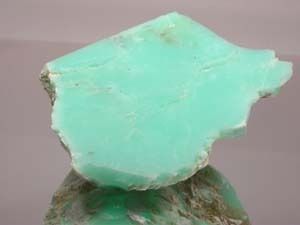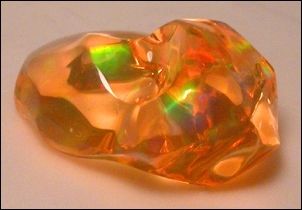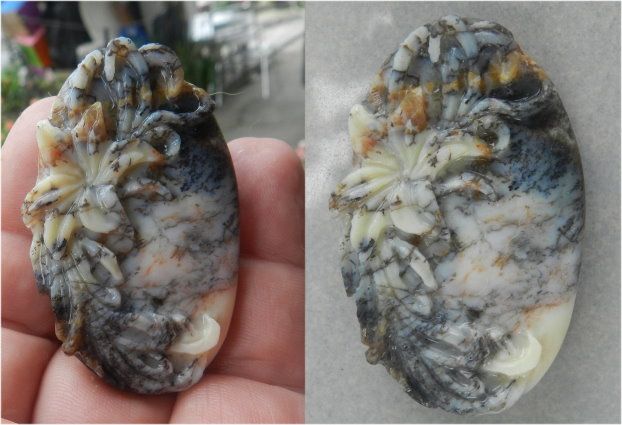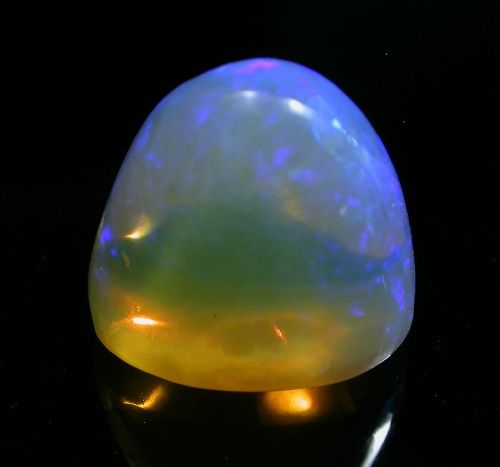Deleted
Deleted Member
Member since January 1970
Posts: 0
|
Post by Deleted on May 15, 2016 22:58:31 GMT -5
Title.
|
|
gemfeller
Cave Dweller 
Member since June 2011
Posts: 4,056 
|
Post by gemfeller on May 16, 2016 1:24:43 GMT -5
They're both the mineraloid opal. (A mineraloid is a mineral-like substance that doesn't exhibit crystallization: "amorphous.") Opal with play of color is called "precious opal" or "noble opal" to distinguish it from "common opal" which is opalite of any body color without POC. As with many other things, proper terms are often not used or misused. For instance "fire opal" is not precious opal because it has no POC, although the name is commonly used in place of precious opal. It's name comes from its fiery red-orange body color and it makes beautiful cut stones especially when well-faceted. When that opal type occasionally has POC it automatically becomes "precious opal." There are also many confusing trade names for opalite/common opal. You may hear the term "potch," which is another name for opal with no POC. Macedonian Green Opal – Opalite  Mexican “Fire Opal” With POC – Becomes Precious Opal  |
|
|
|
Post by orrum on May 16, 2016 6:58:30 GMT -5
Good question Sean. I like to knap stone and opalite makes great gem points when knapped. I had a few small slabs of a greenish opalite but they are now used up. Where can you get opalite in at a reasonable price? Knapping grade opalite is not as perfect or maybe a better way to say it is a knapper can work around flaws better than a cabber. Is opalite available in large chunks because what I had was small slabbets. Thanks for the info.
|
|
|
|
Post by kk on May 16, 2016 7:09:56 GMT -5
Another form called Opalite  And just yesterday, I was told that this might fall under the same category too.....  |
|
|
|
Post by orrum on May 16, 2016 8:34:15 GMT -5
Impressive work Kurt!
|
|
Deleted
Deleted Member
Member since January 1970
Posts: 0
|
Post by Deleted on May 16, 2016 10:27:54 GMT -5
And let's not forget that "opalite" has long been a trade name for glass products. Some 'opalite' cabs sold are indeed just man-made glass – the unscrupulous using the ambiguity to rip off consumers. As gemfeller explained so well, the proper terms are either "common opal" or "precious opal" – even when some types of "common opal" are rarer and more valuable than some "precious opal" types – at least until better terms are widely agreed upon (like that's ever gonna happen).
|
|
|
|
Post by kk on May 16, 2016 19:40:32 GMT -5
Right on r2d. The glass version is giving the real thing a really bad name.  |
|
gemfeller
Cave Dweller 
Member since June 2011
Posts: 4,056 
|
Post by gemfeller on May 16, 2016 20:50:35 GMT -5
Kurt, do you think glass "opalite" is doing worse things for genuine precious opal than Sir Walter Scott's 1859 novel "Anne of Geierstein" did? That book virtually killed the European precious opal market for many, many years and the silly "opal is bad luck" myth persists to this day.
I have a personal bias against any man-made "opal" products: Gilson, Inamori and nearly all the others. First, they're not synthetics because they don't accurately duplicate natural material. They very seldom look like it either. They lack water which is a defining characteristic of natural opal. Others are nothing but glorified plastic resin. If people get their jollies from that junk they should just cut up old CD-ROMs and wear them as jewelry.
Lison man-made opal is the only product I can find that's considered a true synthetic by the GIA. I have no personal experience with it and would love to hear from those who do. Their website says the current low cost of abundant beautiful natural precious opal from Ethiopia has undercut production costs of Lison material. They say research will continue. |
|
|
|
Post by kk on May 16, 2016 20:59:52 GMT -5
  Don't know that book. Will have to look it up. But yes, I quite familiar with the bad luck notion. Due to price and fragility, I never really bothered to go for opal. So I do not understand the fuss around it. |
|
Deleted
Deleted Member
Member since January 1970
Posts: 0
|
Post by Deleted on May 16, 2016 21:08:29 GMT -5
Right on r2d. The glass version is giving the real thing a really bad name.  Oh, great, so my opalite is almost certainly glass? Next year at our Gem and Mineral Show I'm gonna call a lot of shenanigans. /r/pitchforkemporium. |
|
gemfeller
Cave Dweller 
Member since June 2011
Posts: 4,056 
|
Post by gemfeller on May 16, 2016 23:58:24 GMT -5
  Don't know that book. Will have to look it up. But yes, I quite familiar with the bad luck notion. Due to price and fragility, I never really bothered to go for opal. So I do not understand the fuss around it.
Well, price and fragility haven't stopped people from buying and loving emeralds (hard but very fragile), pearls (soft), topaz (perfect basal cleavage), diamond (it's hard but not tough -- perfect cleavage in 1 direction on all crystal faces), demantoid garnet (very expensive but soft), fine blue moonstone (cleavage again, soft) and a few others I could name. But opals are a special addiction. My name is Rick and I'm proud to be an opalholic.
|
|
Deleted
Deleted Member
Member since January 1970
Posts: 0
|
Post by Deleted on May 17, 2016 6:29:01 GMT -5
Opal is my birthstone.
"Opalholic" [2]
|
|
|
|
Post by fernwood on Jun 2, 2016 19:29:36 GMT -5
So, was wondering of the opal like forms in the granite and volcano bombs I am finding are jelly opals? They do not have the structure of real opals, but have a blueish rainbow look.
|
|
gemfeller
Cave Dweller 
Member since June 2011
Posts: 4,056 
|
Post by gemfeller on Jun 2, 2016 20:20:18 GMT -5
Most of what opal people call "jelly" is precious opal. Its weak blue-green play of color is usually borderline with the strong POC in so-called "crystal" opal (that name is controversial because opal is non-crystalline (amorphous) and it could be confusing to some. It was named because of its crystal-like transparency.) But you can't judge by names: there have been many attempts to formalize opal nomenclature but most are ignored. This is jelly opal:  As to formation, opal is sedimentary, not volcanic or metamorphic although it's often deposited by silica-rich hot geothermal waters in volcanic areas. Most experts believe that Australian opal around the Great Artesian Basin is a secondary deposit from silica leached from surface rocks by precipitation and deposited in underground crevices. |
|
|
|
Post by Rockoonz on Jun 2, 2016 20:36:04 GMT -5
Right on r2d. The glass version is giving the real thing a really bad name.  Oh, great, so my opalite is almost certainly glass? Next year at our Gem and Mineral Show I'm gonna call a lot of shenanigans. /r/pitchforkemporium. There are some fake opals out there, but lots of real stuff too and fairly easy to tell the difference. Post pictures. |
|